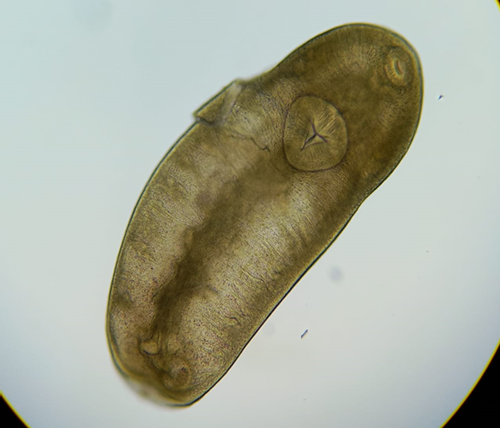Case report: Clinostomum sp. infestation in Pterophyllum scalare and use of Prazicuantel and Pamoato of Pirantel for control
DOI:
https://doi.org/10.56926/repia.v3i1.48Keywords:
metacercaria, parasitism, ornamental fish, treatmentAbstract
An unidentified parasitic agent was analyzed in a batch of Pterophyllum scalare acquired for the Laboratory of Ichthyology and Ornamental Fish of the National University of Colombia, Bogotá. The batch of animals had been previously raised in earthen ponds. As days went by, during the aquarium quarantine period, a fraction of the lot, corresponding to the Koi variety, began to present abnormal white structures in the fins; structures that had a slow dissemination towards the crown area. To determine the causal agent of this phenomenon, a fin sample was analyzed, identifying the presence of metacercariae of the parasite Clinostomum sp. With this information, an antiparasitic treatment was carried out using a drug for small species based on Praziquantel and Pyrantel Pamoate (Vermiplex® from ZOO Laboratories). The drug was administered orally with a dose of 25 mg total of Praziquantel and 75 mg total in the water; achieving a total recovery of the affected animals by completely disappearing the parasitic structures and not presenting relapses after 20 days from the beginning of the treatment
Downloads
References
Barato, P., Penagos, G., Iregui, C., & Figueroa, J. (2012). Mapa Epidemiológico de las Enfermedades de los Peces Ornamentales en Colombia (1a ed.). Universidad Nacional de Colombia. Facultad de Medicina Veterinaria y de Zootencia. Grupo de Patobiología Veterinaria.
Caffara, M., Locke, S. A., Gustinelli, A., Marcogliese, D. J., & Fioravanti, M. L. (2011). Morphological and molecular differentiation of Clinostomum complanatum and Clinostomum marginatum (Digenea: Clinostomidae) metacercariae and adults. Journal of Parasitology, 97(5), 884–891. https://doi.org/10.1645/GE-2781.1 DOI: https://doi.org/10.1645/GE-2781.1
Fernandes, I. M., Bastos, Y. F., Barreto, D. S., Lourenço, L. S., & Penha, J. M. (2016). The efficacy of clove oil as an anaesthetic and in euthanasia procedures for small-sized tropical fishes. Brazilian Journal of Biology, 77(3), 444–450. https://doi.org/10.1590/1519-6984.15015 DOI: https://doi.org/10.1590/1519-6984.15015
Franco Ortega, J. A., Moncaleano Gómez, E. M., & Ajiaco Martinez, R. E. (2021). Comportamiento del mercado de los peces ornamentales continentales en Colombia. Ciencia y Agricultura, 18(1), 63–75. https://doi.org/10.19053/01228420.v18.n1.2021.11320 DOI: https://doi.org/10.19053/01228420.v18.n1.2021.11320
Garcia Varela, M., Sereno-Uribe, A. L., Alejandra López Jiménez, A., Ortega-Olivares, M. P., Andrade-Gómez, L., & González García, M. T. (2023). Vislumbrando la diversidad de clinostomidos (Platyhelminthes: Digenea), parásitos asociados a peces y aves acuáticas en México y Centroamérica mediante información obtenida de la biología molecular. Ciencia Nicolaita, 86. https://doi.org/10.35830/cn.vi86.661 DOI: https://doi.org/10.35830/cn.vi86.661
Hoffman, G. L. (1999). Parasites of North American Freshwater Fishes, 2nd edition. Journal of Aquatic Animal Health, 11(2), 198–198. https://doi.org/10.1577/1548-8667(1999)011<0198:PONAFF>2.0.CO;2 DOI: https://doi.org/10.1577/1548-8667(1999)011<0198:PONAFF>2.0.CO;2
Monjit, P., Chanda, M., Joydeep, D., & Bidipta, R. (2023). Breeding of ornamental fish Pterophyllum scalare (Schultze, 1823) In home environment and its commercialization. International Journal of Creative Research Thoughts (IJCRT), 11(8), 890–907. https://ijcrt.org/viewfull.php?&p_id=IJCRT2308106
Morey, G. A. . (2019). Parasitología en peces de la amazonía: Fundamentos y Técnicas parasitológicas, Profilaxis, Diagnóstico y Tratamiento (1a ed.). IIAP. https://repositorio.iiap.gob.pe/bitstream/20.500.12921/393/1/Murrieta_Libro_2019.pdf
Murrieta-Morey, G. A., Tuesta Rojas, C. A., Echevarria-Matos, A. M., & Chuquipiondo-Guardia, C. T. (2022). Metacercariae of Clinostomum sp. (Trematoda: Clinostomidae) infesting ornamental cichlids cultivated in the Peruvian Amazonia. Neotropical Helminthology, 16(1), 49–56. https://revistas.unfv.edu.pe/NH/article/view/1381
Norbury, L. J., Shirakashi, S., Power, C., Nowak, B. F., & Bott, N. J. (2022). Praziquantel use in aquaculture – Current status and emerging issues. International Journal for Parasitology: Drugs and Drug Resistance, 18, 87–102. https://doi.org/10.1016/j.ijpddr.2022.02.001 DOI: https://doi.org/10.1016/j.ijpddr.2022.02.001
Silva, A. S., Pedron, F. A., Zanette, R. A., Monteiro, S. G., & Neto, J. R. (2009). Effectiveness of praziquantel in the control of the parasite Clinostomum complanatum Rudolphi, 1918 (Digenea, Clinostomidae) in fish of the species Rhamdia quelen Quoy & Gaimard, 1824 (jundiá). Pesquisa Agropecuária Gaúcha, 15(1), 73–76. http://revistapag.agricultura.rs.gov.br/ojs/index.php/revistapag/article/view/209
Sutili, F. J., Gressler, L. T., & Pelegrini, L. F. V. de. (2014). Clinostomum complanatum (Trematoda, Digenea): a parasite of birds and fishes with zoonotic potential in southern Brazil. A Review. Revista Brasileira de Higiene e Sanidade Animal, 8(1). https://doi.org/10.5935/1981-2965.20140007 DOI: https://doi.org/10.5935/1981-2965.20140007
Tarkhani, R., Imani, A., Jamali, H., & Farsani, H. G. (2017). Anaesthetic efficacy of eugenol on various size classes of angelfish (Pterophyllum scalare Schultze, 1823). Aquaculture Research, 48(10), 5263–5270. https://doi.org/10.1111/are.13339 DOI: https://doi.org/10.1111/are.13339
Treves-Brown, K. M. (2000). Anthelmintics. En Applied Fish Pharmacology (pp. 200–205). Springer Netherlands. https://doi.org/10.1007/978-94-017-0761-9_15 DOI: https://doi.org/10.1007/978-94-017-0761-9_15

Published
How to Cite
Issue
Section
License
Copyright (c) 2024 Nicolás Mora-Beltrán, Luis Gabriel Quintero-Pinto, Oscar Antonio Cruz Maldonado, Jesús Alfredo Cortés-Vecino

This work is licensed under a Creative Commons Attribution 4.0 International License.
Authors retain their rights:
a. The authors retain the intellectual property rights (copyright) of the published works, assigning to the journal the right of first publication.
b. Authors retain their trademark and patent rights, and also on any process or procedure described in the article.
c. Authors retain the right to share, copy, distribute, perform and publicly communicate the article published in REPIA (e.g., place it in an institutional repository or publish it in a book), with an acknowledgement of its initial publication in REPIA.
d. Authors retain the right to make a subsequent publication of their work, to use the article or any part of it (e.g., a compilation of their work, notes for conferences, theses, or for a book), provided they indicate the source of publication (authors of the work, journal, volume, number, and date).







